Battle Over California Bullet Train Continues To Slow It Down
SACRAMENTO (CBS SF/AP) — Ongoing negotiations between the California legislature and transportation officials continues to delay the state's high-speed rail project, with the most recent hurdle being a debate over whether the train should be high speed when it launches.
That's a conversation Democrats in the state Assembly want to have amid negotiations over whether to release about $4 billion in bond money for the project. The California High-Speed Rail Authority said it needs that money to continue construction beyond next summer. Democratic Gov. Gavin Newsom included it in his state budget, but negotiations between his administration and the Legislature have stalled. They're hoping to reach an agreement when the Legislature returns for session in January.
It's the latest setback for the project, originally expected to cost $33 billion and be completed last year. Today the vision of shuttling passengers between Los Angeles and San Francisco in less than three hours is a distant dream. The first leg of rideable track, connecting two cities in the Central Valley, won't start until at least 2029, and the project's costs have ballooned to $98 billion.
Little political will seems to exist to either kill the project outright or to give it more resources, leaving construction to continue without a long-term plan.
At the center of the latest dispute is how soon to electrify the line, which rail officials say is a necessity to make the train high speed — the whole idea of the project that voters were sold on. They want to enter into a contract next year for a firm to design and construct an electrified track and system and to maintain it for 30 years, effectively locking in the state for the long haul.
Current plans call for the first rideable leg to go from Bakersfield to Merced, where passengers would ideally be able to hop on another transit line to head into the San Francisco Bay Area in a roundabout way. Rail officials and local transit agencies plan to partner to create a single station in Merced, where riders could get off the high-speed train and onto another system, but the construction of it is not fully funded.
That's prompted Democratic Assemblywoman Laura Friedman, chair of the transportation committee and a lead negotiator on funding, to ask whether it makes sense to fully electrify the line right away. She thinks the authority's money might be better spent ensuring that there's a single station at Merced. That would ensure passengers can get to the coastal job hubs from the Central Valley, even if it's on a diesel train. Overheard electrification could be finished later if there's more money.
"I'm not arguing that that's an optimal solution, but I think that people need to be honest about what we have the money to do right now," Friedman said.
High-speed rail officials and supporters say running anything less than an electrified train goes against what voters endorsed and wouldn't bring the clean energy benefits.
"How does that show that you've made a good investment in the infrastructure if you continue to run the same equipment that we're running today, at relatively similar speeds?" said Dan Leavitt, manager of regional initiatives for the San Joaquin Regional Rail Commission, Altamont Corridor Express and San Joaquin Joint Powers Authority, all of which are partnering with the high-speed rail.
The $4.2 billion in bond money rail officials are seeking to access is the last of the $10 billion fund voters created in 2008, and some lawmakers are hesitant to give it away all at once.
Friedman has proposed releasing $2.5 billion now and requiring rail officials to come back for approval before they enter into a track and systems contract.
She wants more of the high-speed rail money, though her proposal didn't say how much, for projects in the Los Angeles area that she represents. The state Senate has not shared any spending proposals.
Newsom's administration wants electrification.
"We believe the time for slow, diesel-emitting rail is over, and we remain committed to a transportation future that moves people quickly and does so without further polluting our environment," spokesman Daniel Lopez said in a statement.
How to approach the bond money, and what strings to attach, mark a critical decision point around the project's future, said Lou Thompson, chair of the rail project's peer review group, which independently evaluates the funding plans.
"If we are going to build the entire system as (the ballot initiative) requires, then a Bakersfield to Merced high-speed rail line is a perfectly valid piece of the system," he said. "If we're not going to finish the system in its entirety then I think you would think long and hard about electrifying the line just from Merced to Bakersfield."
The ambitious project has been closely watched nationwide as a test of whether the United States can move away from its car culture and catch up with other nations on high-speed rail. Supporters say the completed project would radically change how people travel, while cutting down on carbon emissions. Detractors say it's a taxpayer-funded boondoggle.
"The idea of high-speed rail has become a little bit toxic because of the California project," said Ethan Elkind, an expert on transit projects at the University of California, Berkeley.
In some ways, the project was set up to fail when voters were given a low-ball cost estimate for the project. Later, President Barack Obama's administration conditioned federal funding on starting construction in the Central Valley, he said.
Elkind said the project is still viable, but if it's not electrified, California's ability to compete for money if Congress passes President Joe Biden's infrastructure plan, which includes tens of billions of dollars for rail projects.
"The federal government is going to say: 'Look, California's opted out of high-speed rail.' That's the message it's going to send," he said.
The project just won back $1 billion in federal money that President Donald Trump's administration revoked, and the new contract specifically mentions an electrified train. Democratic Sens. Alex Padilla and Dianne Feinstein in July urged lawmakers to release the bond money, particularly with new federal dollars on the line.
"Now is not the time for California to step back from its commitment to high-speed rail," they warned.
The project has already spent $2.5 billion in federal money and received more than $3.7 billion from California's auction program for carbon pollution credits, known as cap-and-trade. That program is set to end in 2030.
Electrified or not, the project is still short tens of billions of dollars — one reason rail officials cite for building the project in pieces.
"We don't have that much money and we never have," said Melissa Figueroa, a spokeswoman for the rail authority.
© Copyright 2021 The Associated Press. All Rights Reserved. This material may not be published, broadcast, rewritten or redistributed.



